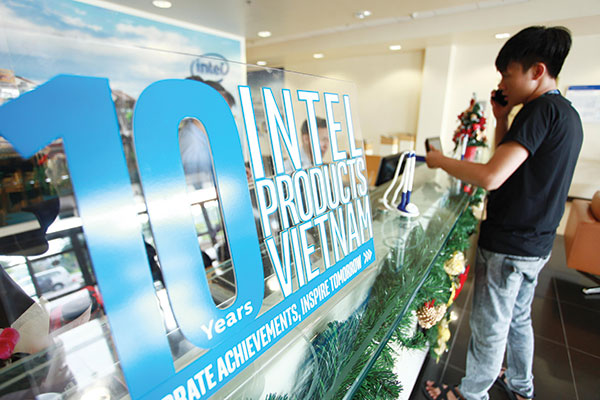Intel invests into building local IoT base
 |
| Intel’s local factory fits in with the company’s future direction Photo: Le Toan |
Sherry Boger, general director of Intel Products Vietnam (IPV), said that the company’s achievements over the past 10 years have inspired IPV to continue investment and expansion in the future. The firm’s investment in its Saigon Hi-tech Park (SHTP)-based plant has reached $1.04 billion.
According to VIR, Intel has a quick and effective disbursement because the US chipmaker has closed some of its international facilities and transferred equipment to Vietnam for the production of the Haswell CPU. It is a fourth generation Intel Core processor, used for desktop and laptop PCs. Previously, the plant in SHTP assembled and tested chips for laptops and mobile devices, in addition to the system on a chip (SOC) in 2013.
During the launch of the Haswell CPU processor in late July 2014, Borger said that the new made-in-Vietnam product will improve Intel’s testing and assembling capacity globally.
“We chose Vietnam because the Vietnam manufacturing site is the largest overseas facility of Intel,” Borger said. “The error rate of the made-in-Vietnam chips is low, so 80 per cent of the semiconductor chips used in computers around the world could be made by the Intel plant in Vietnam.”
By the end of 2016, the Intel plant in SHTP has achieved a total output of 600 million units. IPV has assembled and tested 26 production lines including chips for wrist devices and unmanned aerial vehicles.
“Intel is upbeat about the outlook of the Vietnamese plant. In 2017, we will expand Intel’s Class 10,000 clean room facility to keep up with the latest technology,” Borger said.
Intel has been shifting to focus on powering data centre infrastructure and the Internet of Things (IoT) following its global restructuring. The technology research firm Gartner predicts there will be 24 billion IoT devices by 2020.
Intel Vietnam used to produce chips in a Class 100 clean room, but they will switch to the Class 10,000 clean room to produce smaller IoT products. The expansion indicates that IPV will need more space to build the Class 10,000 clean room facility.
Intel has also joined forces with Vietnam’s VNPT Technology to set up a lab reserved for IoT, which is first of its kind in the country and among the few IoT labs in the world.
IoT is going to impact business widely, in manufacturing, retail, automobile, transport, healthcare, and real estate. As a pioneer of IoT, Intel is expected to attract more IoT suppliers to Vietnam in the future. The entry of these companies will spur demand for skilled labour to join the supply chain.
Intel Vietnam has had many initiatives to train the local workforce to meet American standards. The Higher Engineering Education Alliance Programme (HEEAP) is the first educational project under a public-private partnership with the Accreditation Board of Engineering and Technology (ABET). The programme has trained over 5,000 educators in eight partner universities, and granted 454 scholarships for female students from 15 colleges and vocational schools in Vietnam.
What the stars mean:
★ Poor ★ ★ Promising ★★★ Good ★★★★ Very good ★★★★★ Exceptional
Latest News
More News
- Mitsubishi Estate launches Logicross Hai Phong - a milestone in logistics evolution (November 20, 2024 | 14:32)
- Semiconductor workforce partnerships deliver industry-relevant training (November 20, 2024 | 10:58)
- German Quickpack to invest $31.7 million in Long An province (November 20, 2024 | 09:31)
- Foreign-invested enterprises drive logistics investment in the southeast region (November 20, 2024 | 09:27)
- Chile visit underscores trade benefits (November 19, 2024 | 10:00)
- Trump’s second term impacts sci-tech activities and industry 4.0 technologies (November 18, 2024 | 10:00)
- Vietnam eyes nuclear revival to bolster energy security (November 14, 2024 | 16:46)
- Kyokuyo completes $13.5 million seafood factory in Vietnam (November 14, 2024 | 12:19)
- VinFast receives $3.5 billion funding from Vingroup and Pham Nhat Vuong (November 14, 2024 | 06:38)
- Localities sprint to reach FDI targets (November 13, 2024 | 10:00)


















 Mobile Version
Mobile Version